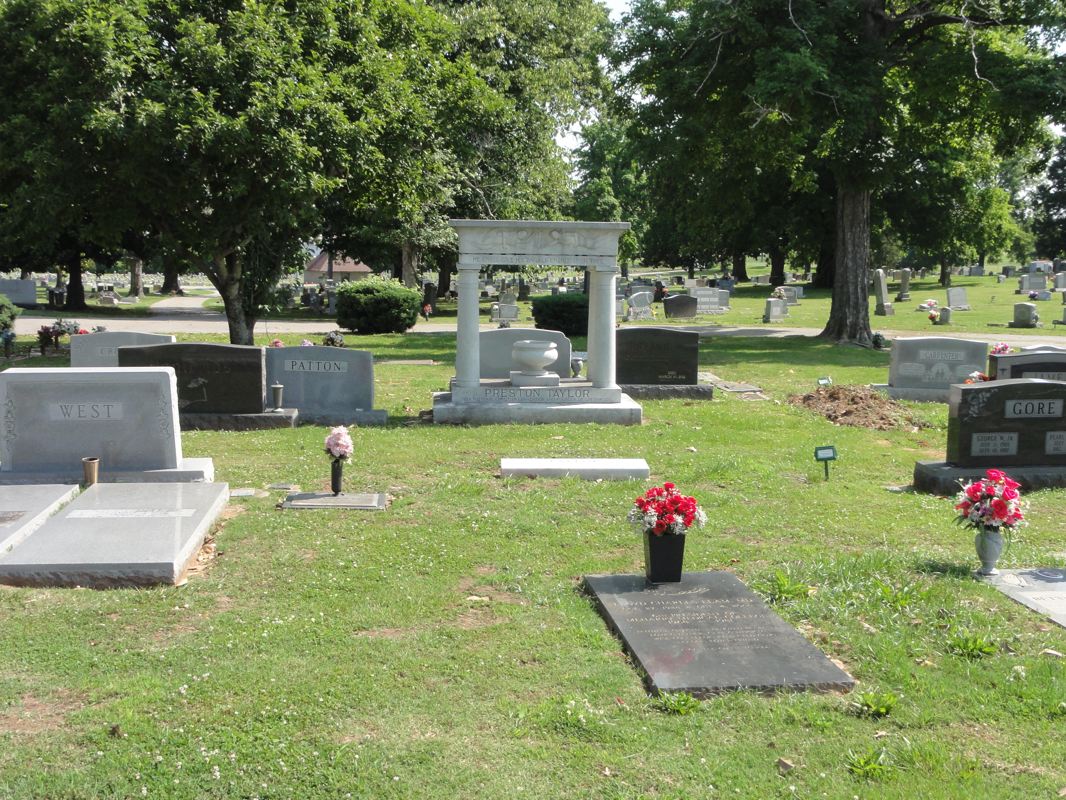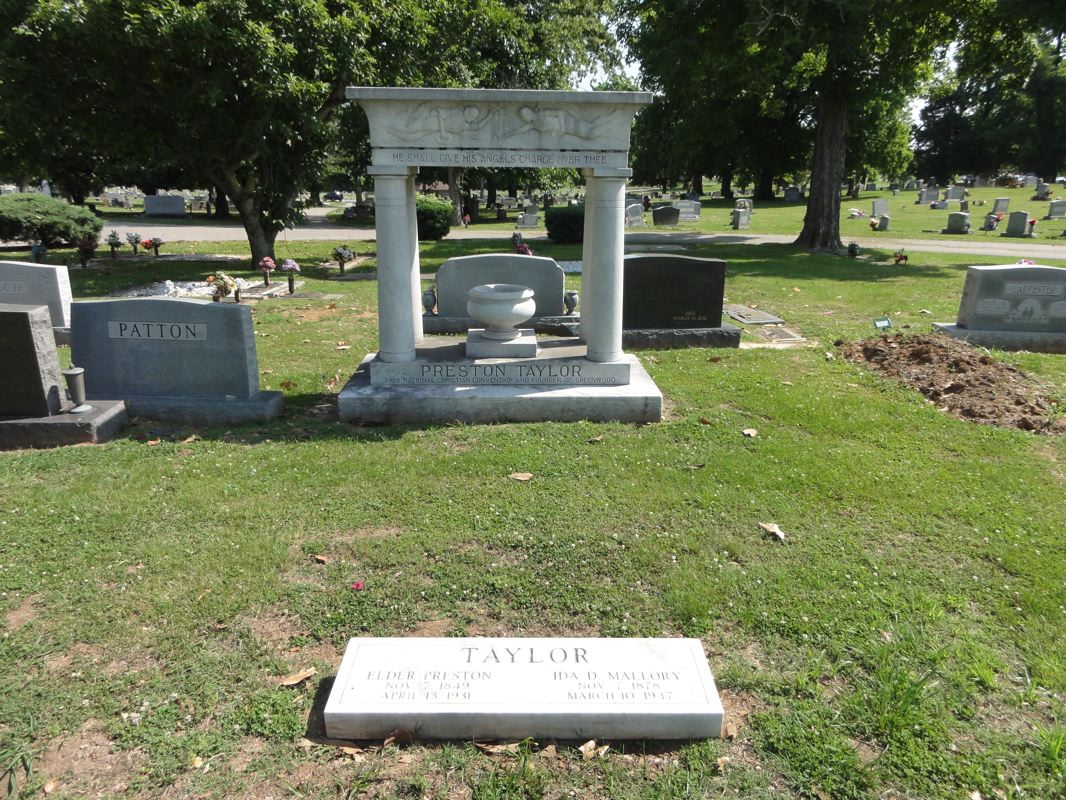Preston Taylor
1849-1931
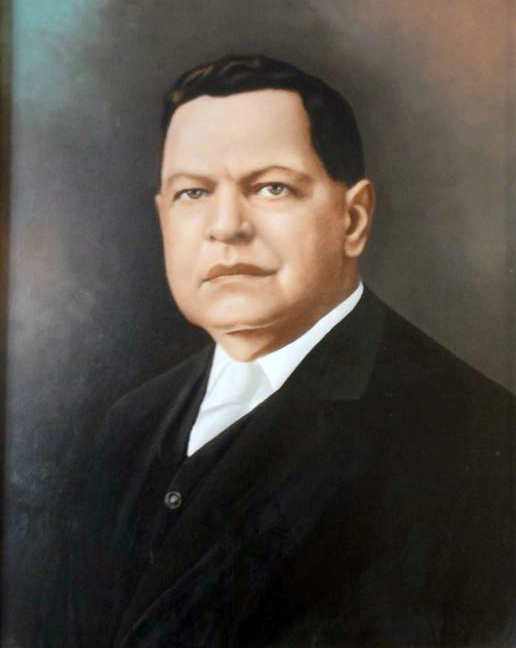
Courtesy of Greenwood Cemetery, Nashville, Tn
(Click on photos for zoom)
![]()
Sketch On The Life Of Preston Taylor
Preston Taylor was born in Shreveport, Louisiana, on November 7, 1849, of slave parents. Taylor served as a drummer boy in the Union army during the siege of Richmond, Virginia. After the Civil War, he traveled throughout the North, but settled at Mount Sterling, Kentucky, as a minister. Deeply affected by the exclusion of Negroes from local Reconstruction projects, Taylor secured a contract to build several sections of the Big Sandy Railway from Mount Sterling to Richmond, Virginia. After this successful business venture and extensive work in the Christian (Disciples of Christ) Church, he moved to Nashville.
Taylor arrived in Nashville around 1884. By the early years of the twentieth century, he had become one of Nashville's most influential black business and religious leaders. He married Georgia Gordon, one of the original Fisk Jubilee Singers. Their son, Preston, died as an infant in 1891, and Mrs. Taylor died in 1913. Taylor then married Ida D. Mallory.
In 1887, Taylor purchased thirty-seven acres of land near "Buttermilk Ridge" at Elm Hill Pike and Spence Lane. Upon this dairy land, in 1888, he established Nashville's second oldest cemetery for blacks, Greenwood. Also in 1888, he founded Taylor Funeral Company at 449 North Cherry Street (now Fourth Avenue).
In 1905, he extended his holdings with the purchase of thirty-seven and a half acres of land near the corner of Spence Lane and Lebanon Road, for the purpose of establishing the Greenwood Recreational Park for Negroes. The park was elaborate, with fountains, gardens, shows, good stands, a baseball park, rides, band stands, and special attractions. The annual State Colored Fair was held there, where at times some 14,000 persons attended in a single day. His horse-drawn "pleasure wagons" met the electric streetcars at the Green-Fairfield Street turnaround and took the customers to the Lebanon Road entrance of the park. Mysterious fires threatened twice to destroy the park. Otherwise, there was no challenge to Greenwood Park until the first city-owned park for Negroes, Hadley Park, was opened in July of 1912. Taylor's business ventures made him a wealthy man.
After moving to Nashville, Taylor became minister of the Gay Street Christian Church, founded in 1855 as the Negro congregation of the white Vine Street First Christian Church. In 1891, due to a controversy, the Reverend Taylor and a part of the congregation left the Gay Street Colored Christian Church and established a church in a doctor's office building on Spruce Street (now Eighth Avenue). In 1903, the congregation completed a church building on Lea Avenue near Lafayette Street. After Taylor's death, the two congregations united into today's Gay-Lea Christian Church, located on Osage Street.
Among his other activities were the organization in 1917 of the National Colored Christian Missionary Convention and involvement in the establishment of Tennessee State Agricultural and Industrial State Normal College in 1909. He also helped organize several other Nashville black businesses, including the One Cent (Citizens) Savings and Trust Company Bank.
As a businessman, undertaker, and influential minister, Preston Taylor was one of Nashville's most powerful black leaders. Upon his death in 1931, week-long ceremonies were held before his interment in Greenwood Cemetery. In 1951, a public housing project was named in his honor.
-Copied, Joe E. McClure, Tennessee State Digital Library
![]()
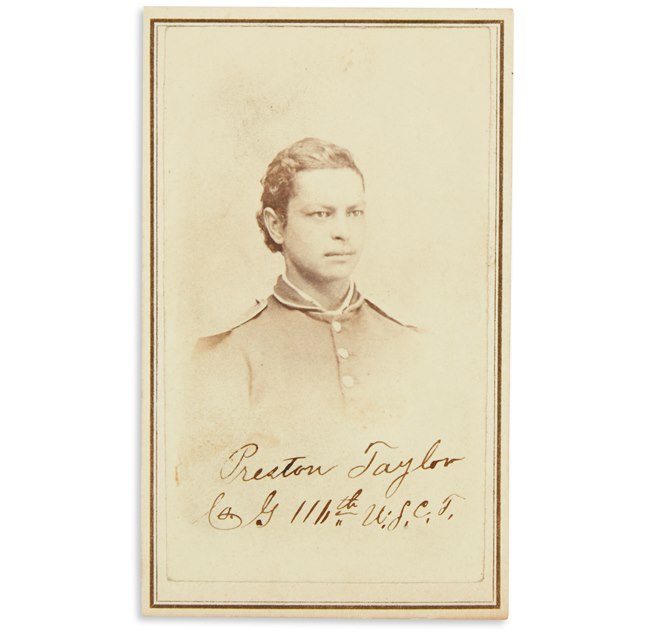
Smithville: Indomitable Preston Taylor
It appears that the first attempts at restoration within the black community in Montgomery County came about by a former slave who had received his freedom for services rendered in the Union Army during the Civil War. Preston Taylor was born of slave parents in Shreveport, Louisiana on November 7, 1849. After traveling throughout the North following the war, in about 1870 he accepted an invitation to come to Mt. Sterling as a minister. Evidently, during his travels, or perhaps while residing in Louisville immediately after the war, he came into contact with the plea for restoring New Testament Christianity. Taylor remained in Mt. Sterling until about 1885, at which time he moved to Nashville, Tennessee where he remained unto the end of his life. (Nashville Conference on Afro-American Culture and History, Department of History, Tennessee State University (Nashville: Metropolitan Historical Commission, 1983)
The eventual move of Preston Taylor to Nashville was most likely predicated upon his success in Mt. Sterling, where he, in extraordinary fashion, distinguished himself as both a business man and a preacher. About the time he arrived in Mt. Sterling, contracts were being let for the extension of what was known at the time as the Big Sandy Railroad, which was being extended eastward from Mt. Sterling. The destination was Richmond, Virginia. Contractors were refusing to hire black men, choosing to employ Irish labor instead. To rectify this injustice, Taylor, who had had some experience with railroading in Louisville, submitted bids for two sections and was awarded a contract. ("The Big Brother of our Zion Dies," (The Christian Plea Supplement) The Nashville Globe, 15 April 1931, pp. 4-5.) Considering the magnitude of the task of gathering equipment necessary for such a project, the undertaking was certainly a tribute to his courage and to his sensitivity to that which he considered to be an injustice to those of his race.
A second achievement attributed to him while in Mt. Sterling was the "building up of the largest congregation in the state among those of his faith, besides building them the finest brick building as a place for the worship of God in the state." It is further declared that during his fifteen years in Mt. Sterling that "he became known as the leading minister of his church in the United States . . . (Ibid.) As "agent of the colored Christian Church," Taylor was the responsible person in the execution of a promissory note for ninety-five dollars. . . “ (Mortgage Book No.2, Courthouse, Mt. Sterling, Kentucky, p. 8.) More than a century later the building served as a place of business. In 1964 the High Street Christian Church, which considers 1874 as its year of organization, moved to a new location four blocks east of the original property.
-Donaldson, Everett, History of the Church of Christ in Montgomery County, Kentucky, as a part of Triumph and Tragedy: Cane Ridge To The College of the Bible and More, ed. Paul Vaughn, Jr. pages 72,73,78
![]()
ALEXANDER CLEVELAND CAMPBELL:
A NEGRO PREACHER: FIRST TO WITHDRAW FELLOWSHIP
FROM THE "ORGAN" CHRISTIAN CHURCH
The first Nashville preacher to withdraw from the "digressive fellowship" of the Christian Church was a Negro named Alexander Cleveland Campbell some five years before David Lipscomb made a similar move. However, Lipscomb had fully made up his mind some ten years before that the division between the churches of Christ and the Christian over the "organ" and "missionary society" was already an accomplished fact. "Aleck" Campbell made his move around 1900. A family tradition holds that Aleck had come under the influence of Lipscomb in the late 1890's.
Marshall Keeble identified three North Nashville preachers who shaped the course of the Restoration movement among the black Disciples: namely, Alexander Cleveland Campbell, S.W. Womack, and G.P. Bowser. White people's interest in the spiritual welfare of black people dates back to Barton W. Stone. Negroes worshipped in the Cane Ridge meeting house seated in a balcony especially built for them.
A fact little known in the churches of Christ is that the history of the Restoration among black people cannot be fully told apart from a black preacher in Eastern Kentucky. Preston Taylor was the most widely known and honored Negro leader in the Christian Church from 1876 until his death in 1931. With permission from Issac Errett, Taylor for eight years edited a department in the Christian Standard titled "Our Colored Brethren" in which the evangelistic work of black people was chronicled (1876-1884).
Taylor was born November 7, 1848, in Shreveport, Louisiana. His parents moved to Kentucky in his infancy. When the Civil War broke out, Taylor joined the Union Army as a drummer and was present at the surrender of General Robert E. Lee. Taylor became the pastor around 1870 of the Mt. Sterling Christian Church in Kentucky. He moved to Nashville in 1885 and one year later became the pastor of the Gay Street Christian Church. Taylor was dismissed by the elders of the Gay Street church charged with immoral conduct. Taylor then took the lead to establish another Negro fellowship. In 1894, his efforts led to the establishing of the Lea Avenue Christian Church where he remained as pastor until his passing in 1931. Taylor became a wealthy and honored citizen of Nashville and recognized by both white and black people. Taylor was an outspoken and aggressive partisan for the civil rights of black people.
Taylor appeared on the national religion scene when he and H. Malcolm Ayers took the lead in forming the National Convention of the Churches of Christ for black people. He was appointed by the National Convention of the Christian Church to be the national evangelist for work among black Disciples in 1883. These early efforts bore fruit when Negro leaders from widely separated places met August 5-9, 1917, in Nashville, Tennessee, to fonn the National Christian Missionary Convention as an inclusive Negro organization. Taylor was selected as the first president and held the post for many years. This is the historical background to the life and work of Alexander Cleveland Campbell. This infonnation is crucial for understanding the importance of Campbell in Restoration history. He was a member of the Lea Avenue Christian Church pastored by Taylor.
During the same period, S. W. Womack, the father-in-law of Marshall Keeble, was a member of the rival Gay Street Christian Church where G.P. Bowser and his family also attended. Campbell was a native of Wartrace, Tennessee, where he was baptized by D.M. Keeble, uncle of Marshall Keeble. Campbell joined the Lea Avenue church upon moving to Nashville. According to a tradition in the family related by a daughter of the preacher, Alexine Campbell Paige, Campbell came under the personal influence of David Lipscomb who influenced Campbell to oppose the "organ" and "missionary society." Taylor even then was an ultra-liberal adopting the same standards as the present liberal Disciples of Christ. Denominational preachers occupied Taylor's pulpit when he was away. During such a service, Campbell took the floor to denounce the presence of a Baptist preacher in the pulpit. The organist and church choir were directed to drown out the voice of Campbell, whereupon he left with his family and started conducting worship in his home. He was soon thereafter joined by Womack and Bowser with their families.
In 1906, Campbell and his group purchased a frame building on Jackson Street in North Nashville for a place of worship. This was perhaps the first Negro church who worshipped without the organs for scriptural reasons. From those days of "small beginnings," the growth of churches among the Negro race has been phenomenal with numerous strong and viable churches of Christ across the nation and in many foreign nations.
Aleck Campbell is not so much remembered for his accomplishments as he is for what he started. A good example of Aleck's preaching tactics can be illustrated by a meeting he conducted in a schoolhouse in Lawrenceberg, Tennessee. He so inflammed the sectarians that the building was locked. Campbell convinced the school officials he meant no harm and he re-gained access to the school. A favorite place for preaching in Nashville was down on the wharf located on the Cumberland River. Campbell often preached there to men who came to loaf and wait for a job.
In 1906, CA. Moore, an associate of David Lipscomb, gave Aleck a tent for meeting work. The tent was set up on Horton Street in September where Campbell preached into December. In this same year, he conducted meetings in private homes in Blackton, Arkansas, and Smyrna, Tennessee. Lipscomb and his associates' financial support had to be limited, but such greatly helped pioneer preachers as Aleck Campbell. In 1915, Aleck wrote for the Gospel Advocate a summary of preaching efforts that year: "I preached under brush arbors, on the riverside, in the courthouse yard at Pulaski, Tennessee, in the streets, on the pike, in Christian meeting houses. in Baptist houses, and in private homes .. " number of sermons preached, 275. number of additions, 65.'"
Biographical information on Campbell is scant. The writer interviewed two of his surviving children in the late 1960's, Robert Campbell and Alexie Campbell Paige. Campbell died in 1930 in St. Louis where he Was then living with his mother and sister. The legacies of S. W. Womack and G .P. Bowser are in evidence today. S.W. Womack was an outstanding preacher among black people. He was a school teacher and highly literate by standards among black people then. However, his greatest legacy is Marshall Keeble. G .P. Bowser was the best educated and his greatest legacy is Southwestern Christian College in Terrell, Texas. Campbell's enduring legacy is that he Was the father of the Restoration movement among black people who discarded innovations in the worship and work of the church.
-Choate, J.E., 1987 Freed-Hardeman Lectures, pages 38-40
![]()
Directions To The Grave of Preston Taylor
Preston Taylor is buried in the Greenwood Cemetery, Nashville, Tennessee, located at 1428 Elm Hill Pike. It is an African-American cemetery. It is located just down the road from the Gospel Advocate Bookstore. If heading west on I-40, take Exit 213, Spence Lane and turn right. Turn left on Elm Hill Pike, and entering the cemetery on your right. When you enter you will come to a roundabout. Taylor is buried in the middle section. It is an impressive monument in the middle of the section.
GPS Location
36.144719,-86.724173
View Larger Map
![]()
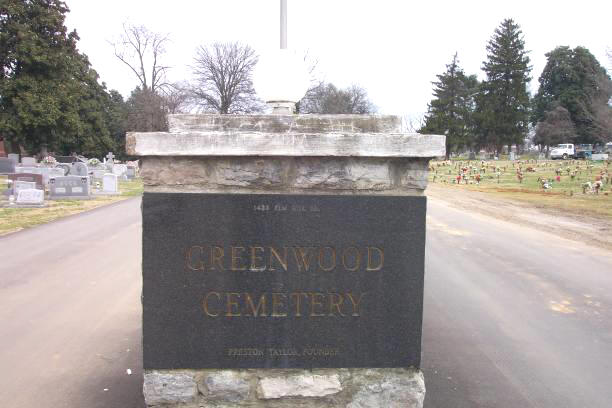
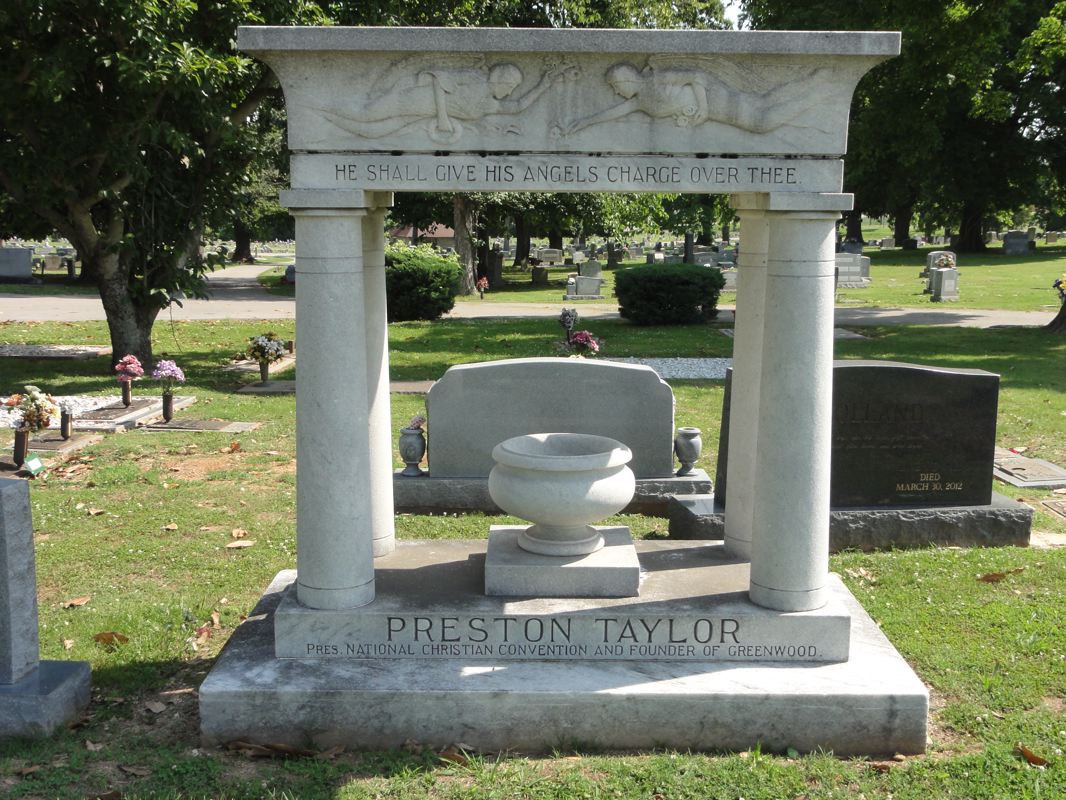
He Shall Give His Angels Charge Over Thee
Preston Taylor
President National Christian Convention And Founder Of Greewood
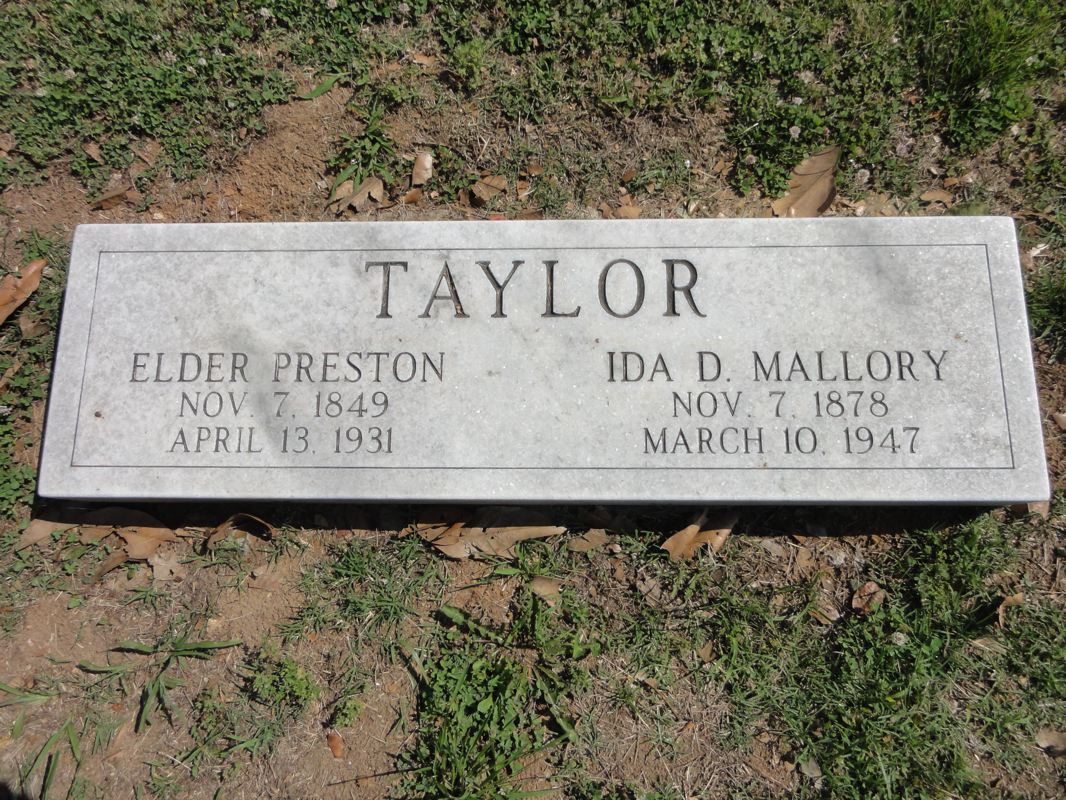
TAYLOR
Elder Preston Taylor - November 7, 1849 - April 13, 1931
Ida D. Mallory - November 7, 1878 - March 10, 1947
![]()
Photos Taken May 21, 2012
Courtesy of Scott Harp
www.TheRestorationMovement.com
Web Editor's Note: The day I visited the grave of Preston Taylor, I had just begun a week's Restoration Research trip with my dear friend Tom L. Childers. We had been set to meet at Crieve Hall Church of Christ where I would leave my truck at around 10am. As I arrived early in Nashville, I had an opportunity to run over to Greenwood Cemetery to see if I could find the grave of Preston Taylor. The people in the office were very helpful, and the location was identified. Taylor's grave is easily identified as you enter the cemetery, as it is in the circle straight ahead from the entrance.
![]()
